Selecting from the diverse iris varieties can be quite daunting. Typically, irises feature three petals, symbolizing faith, wisdom, and valor. In the United States, the prevalent bearded iris takes center stage, categorized into 12 distinct classes by experts. Evaluating the class and other unique characteristics of irises aids in making an informed choice for your flowerbed.
Different types of Red Irises
Iris ‘War Chief’
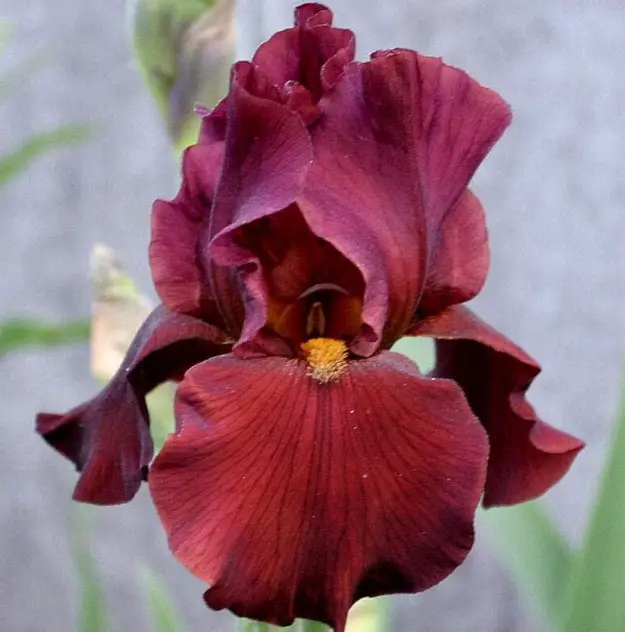
Strong and hardy in zones 3-8, Iris ‘War Chief,’ a member of the Tall Bearded group, grows to a height of 2-3 feet in full light. This cultivar has golden amber beard and neck, with velvet-red petals that are velvety to the touch and gently ruffled. War Chief’ is notable for having a habit of many branches, with up to 14 flowers per plant and 4 branches growing from the main stem. Its garnet-colored blossoms contrast sharply with its erect, brilliant green leaves, which keeps their vivid color even in intense sunlight. Plant “War Chief” on high ground with exposed rhizomes for best flowering potential.
Iris ‘Red Velvet Elvis’
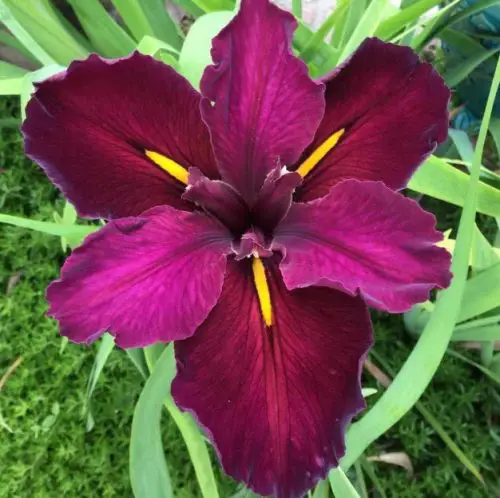
The fascinating bog iris ‘Red Velvet Elvis’ grows to a height of two to three feet in full sun and is hardy in zones 6 through 9. This violet-hued iris, with its ruby red petals, thrives in extremely wet soil and can withstand standing water up to 6 inches deep. These circumstances are best achieved in a home landscaping or container garden with additional care, though they are best placed close to a creek or pond. The chartreuse green leaves of “Red Velvet Elvis” contrast with the darker foliage, adding visual appeal. This cultivar spreads swiftly once it gets established, therefore it needs lots of space to move around.
Iris ‘Bernice’s Legacy’

The Tall Bearded German iris ‘Bernice’s Legacy,’ a reblooming variety, grows to a height of 2-3 feet in full sun and is hardy in zones 3–10. This cultivar gives the added benefit of many blooms in a single season, along with highlights of cinnamon and beards of amber. Its strong, brilliant green leaves hold their color far into the fall, and its magnificent flowers have scalloped edges, tall standards, and wide, drooping falls. Cutting faded flower stems back to the highest set of leaves after the late spring bloom promotes the growth of new stalks. Make sure rhizomes are planted deep in the soil and divide every three to four years to avoid crowding.
Iris ‘Red Beans’
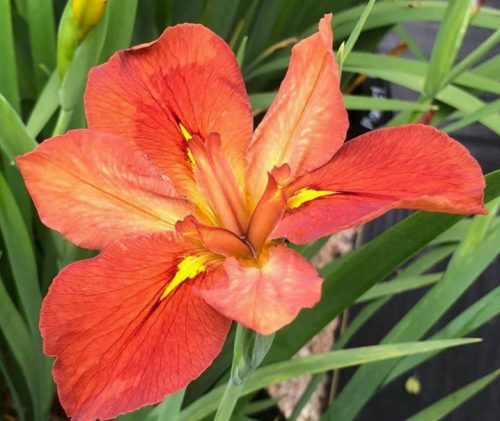
The Louisiana water iris, or iris “Red Beans,” is hardy in zones 6–9, grows to a height of 1-2 feet, and flourishes in full sun. This variety is perfect for damp southern environments and marshy places. It has brick-red flowers with black veining and neon yellow signals that dangle from the throats. The petals have a tiny shearing at the edges and recur like a lily. “Red Beans” has strong, eye-catching leaves that look good even in standing water, with most stems bearing several flowers and double branches. For best growth, the rhizomatous roots of this cultivar need regular hydration.
Iris ‘Quechee’
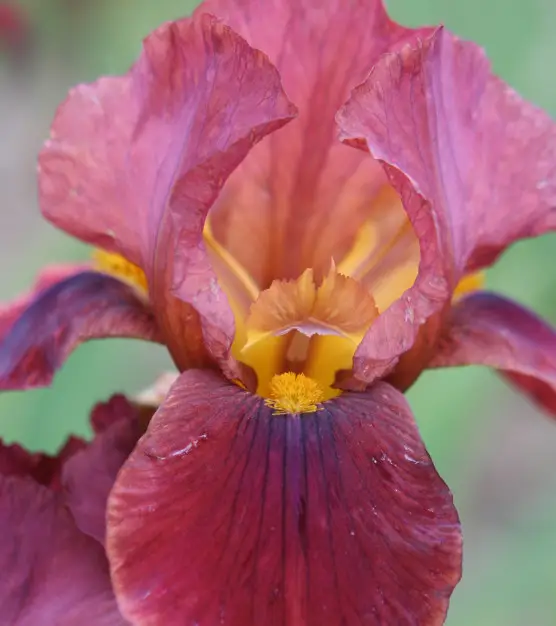
‘Quechee,’ a gorgeous Bearded Iris, grows to a height of two to three feet and is hardy in zones three through nine. It is a full sun plant. Its large, spade-shaped petals have softly ruffled edges and display an enticing rich garnet red with bronze overtones. A dramatic contrast is created by the large yellow beards and the bright yellow throat. These blooms have a three-week blooming period and emit a subtle chocolate aroma. Sturdy stems with thick, sword-like green leaves that endure until fall relieve the need for staking. ‘Quechee’ is a member of the prestigious Tall Bearded class and looks great planted among yellow iris species for a jewel-toned color scheme.
Iris ‘Ann Chowning’
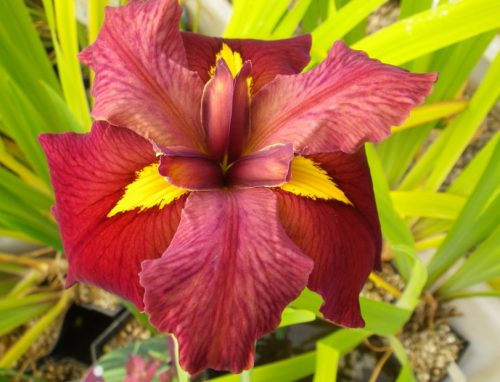
Belonging to the Louisiana iris family, iris ‘Ann Chowning’ grows to a height of 2-3 feet and thrives in zones 4–10. Its deep crimson veining, vivid yellow throats, and classic red blooms with golden highlights all contribute to their timeless attractiveness. Its roots can withstand standing water and spread swiftly in naturalized environments, where it thrives in low regions along stream banks, marshes, and ponds. The native marshy habitat of ‘Ann Chowning’ requires very little care. Slow-draining areas are ideal for its growth when grown in controlled environments, and careful watering is crucial. It can successfully replicate its ideal marshy habitat in planter boxes with drainless bottoms and drums.
Iris ‘Red Rider’
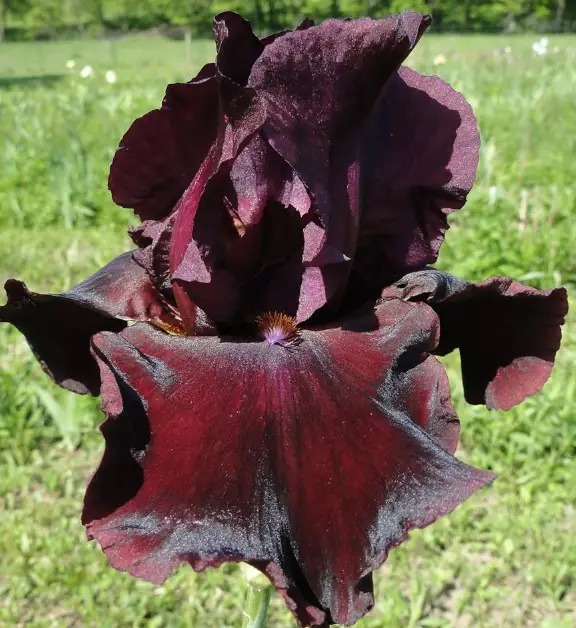
German iris ‘Red Rider’ is a striking variety that grows to a height of 2-3 feet in full light and is hardy in zones 4-8. Its wine-colored, satiny flowers with slightly textured petals and rich red veins and scalloped edges are the major draw. Amber tones are seen in the throats, which are matched by beards. “Red Rider” grows best in well-drained soil and is resistant to deer and drought once established. Every three or four years, split clumps to avoid crowding and guarantee a plentiful crop of blossoms. The 7–10 day-old cut blossoms have a lovely, subtle fragrance.
Iris ‘Red Ember’
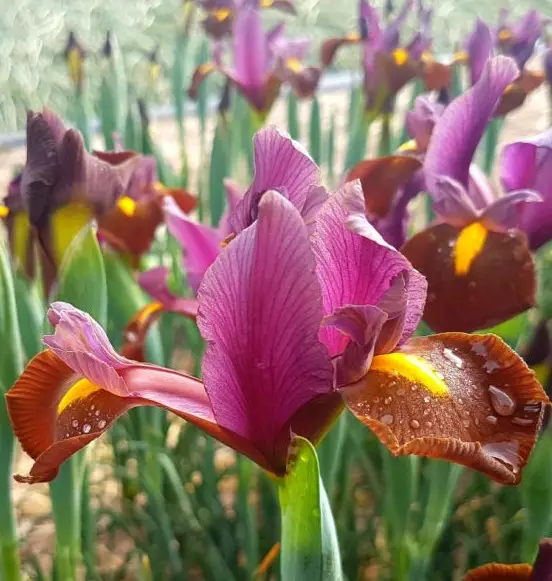
Iris ‘Red Ember’ presents a unique but enthralling combination of red-dominated tones. This Dutch iris grows to a modest height of 18 to 22 inches and is hardy in zones 5 through 9. It thrives in full sun to moderate shade. Its plum-colored, tall standards and rich, copper red falls with splotches of bright yellow give it a unique beauty, even though it is smaller in scale than German irises. Its distinctive charm is enhanced by its thin, grass-like leaves. Tall, straight branches make ‘Red Ember’ a sturdy option for vase presentations, and planting it in huge drifts accentuates its natural appeal.
Iris ‘Grateful Red’
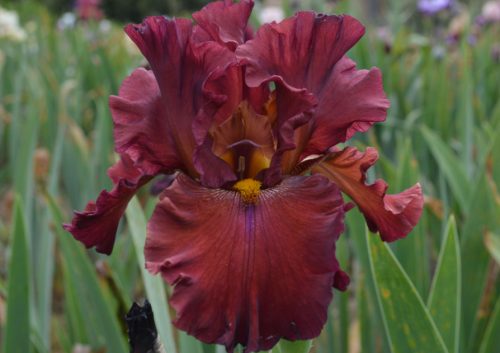
Iris ‘Grateful Red,’ an amazing Tall Bearded iris, grows to a height of 2-3 feet in full light and is hardy in zones 4–8. With three to four branches yielding up to eight blooms on per stem, this variety has abundant and tightly packed flowering. Sweet and fluffy petal ruffling adorns the bronze-red blossoms, which are accented with violet and chocolate. The attraction is heightened by its amber-colored whiskers. Grateful Red,” which is excellent for producing drama and a striking color scheme, needs close attention to planting depth in order to properly flower. To prevent over-saturation, use a rain gauge or moisture sensor and refrain from chopping back leaves until they go brown and fall over.
Iris ‘Spartan’
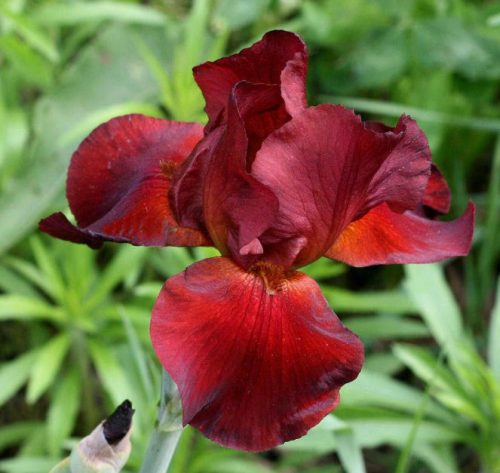
With its striking blood-red blooms accented with golden overtones and vivid orange highlights, Iris ‘Spartan’ shines out. This cultivar is hardy in zones 3–8, growing to a height of 2-3 feet in full sun. Spartan’s velvety, gently ruffled petals, along with similarly colored beards and brilliant bronze throats, create an enthralling focal point. This iris is well-known for its ability to withstand heat, cold, wind, rain, and other extreme weather, making it appropriate for exposed areas with unstable conditions. ‘Spartan’ thrives best in direct sunlight, although it’s still beautiful with some afternoon shade.
Iris ‘Little Cajun’
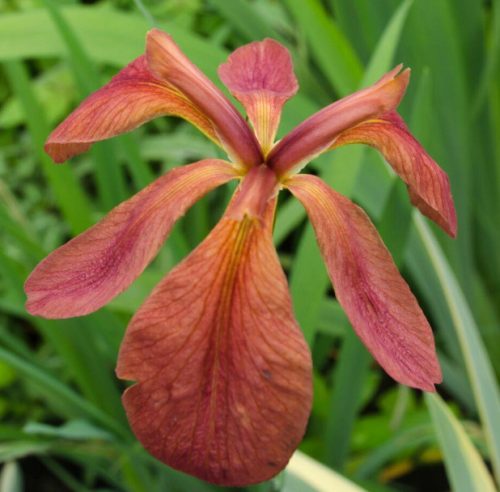
The semi-aquatic iris known as “Little Cajun” is a member of the Iris fulva family. It grows to a height of 18 to 22 inches in full light and is hardy in zones 6 through 9. This type of iris thrives best in a damp environment and is found flourishing in wetland or water’s edge places in humid, southern regions. “Little Cajun” has long, thin petals with little frill. The colors range from cinnamon to coppery red, and the veins and throats are yellow. It spreads readily and should be planted in an area where it can be restricted or allowed to expand due to its medium-width bright green leaves. At the conclusion of the season, the leaves naturally wither back.
Conclusion
Exploring the colorful world of red irises offers a spectacular variety of choices, each with its own distinct appeal and qualities. These red irises give the garden a pop of color and grace, whether they are called “Red Ember” for their fiery color or “Red Velvet Elvis” for their graceful charm. These crimson irises are truly one of nature’s masterpieces, enhancing landscapes and delighting lovers everywhere in the world.
People Who Read This Also Read:






